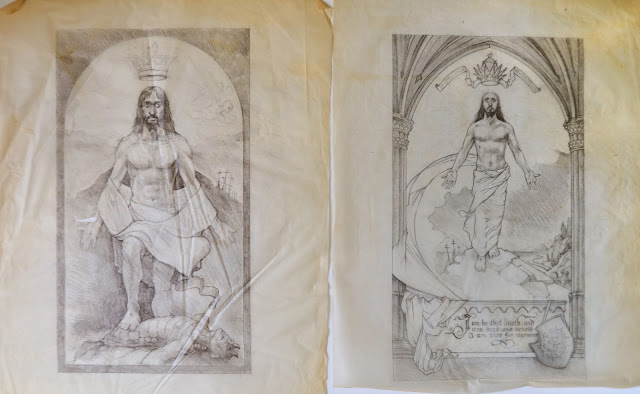 |
| Preparatory drawings for "Resurrection." Edward Riojas. 1999. (Copyright © Edward Riojas) |
Copyright © Edward Riojas
Sometimes I change my mind.
An intimate part of creating art is the making of decisions. In fact, just about everything I do as an artist has to do with choices: How large should the piece be? What medium should I use? What will the image be? What figures will be in that image? How should they be posed, and what expressions should they bear, and what style will work best? Is that color too harsh? Is the quality of that line appropriate? And on and on.
Arguably, the decisions become more involved with sacred art. They also become more critical. The difference between playing it safe and being bold can have a direct bearing on what – and to what extent – the finished piece confesses.
Years ago, when I was conceptualizing what has become one of my most popular images, I changed my mind about who was going to be in the painting. “Resurrection,” a painting that now hangs in the narthex of Our Savior Lutheran Church, Grand Rapids, Mich., was originally going to be a bit different. In the first preparatory drawing I did for the piece, the Victorious Christ had one foot on the body of Satan. It was a variation of an old convention, confessing that Satan was indeed done in by the death and resurrection of Jesus Christ. But then I changed my mind.
 |
| "Resurrection" Edward Riojas. 1999. |
It wasn’t that Christ somehow failed to defeat Satan – He did. Rather, it was because I decided that Satan is such an idiot that he doesn’t deserve to share any of "the limelight" in the resurrection. Like a spoiled child that keeps up a tantrum; like the fallen angel that endlessly accuses, sometimes it’s best to simply ignore him. Sure, we know he's still there, but the guy is a total jerk and no one wants to invite him to the party.
So I did a second drawing without bothering to give Satan any undue recognition. If, however, you still think that Satan should be somehow represented as part of the redemption equation, feel free to imagine him as being very small, and still under the foot of our resurrected Lord.














